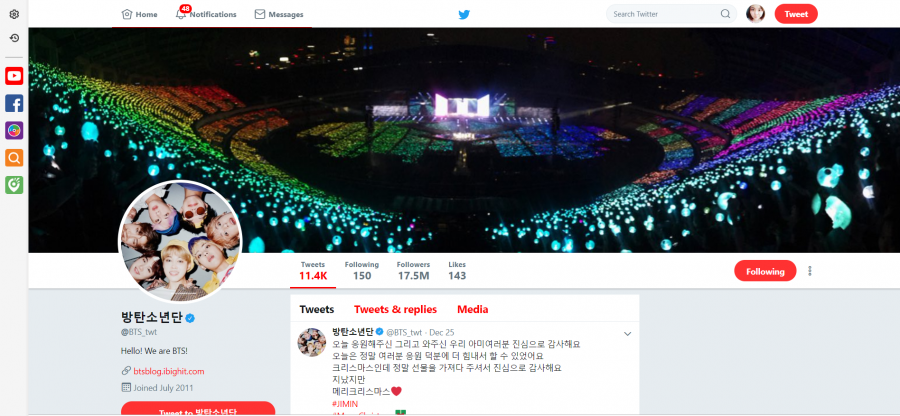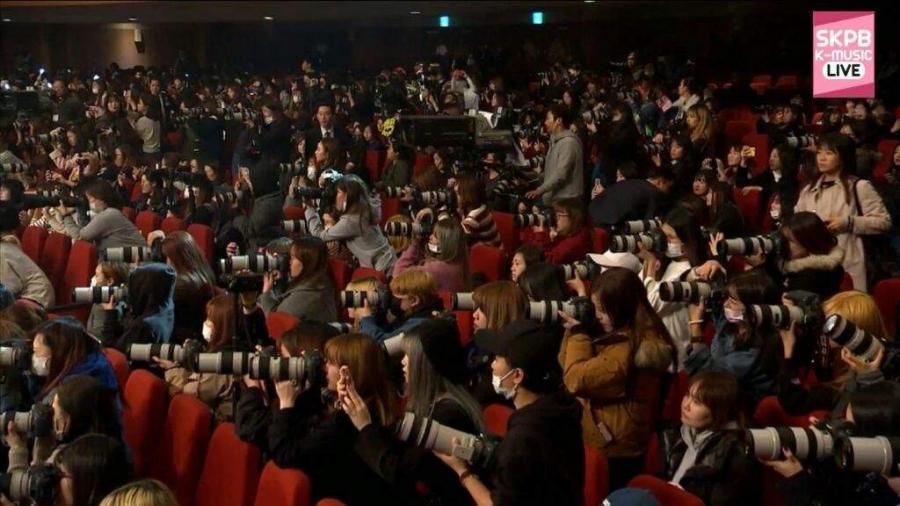
Master-nims and K-pop's social media empire
If you are part of the K-pop world, you are definitely acquainted with the term “master-nims”. Master-nims are probably unique in the history of fan culture and their uniqueness differentiates K-pop fandoms from those of any other music industry.
In this article, I will analyse the importance of both master-nim fan culture and social media for the popularity of K-pop. My case study focuses on BTS, one of the most successful K-pop boy bands. For this band social media is the main source to create fandom and achieve global recognition.
K-Pop's master-nims
Master-nims are fans. They do not work for any company; they can, however, follow their idols legally. So, they have privileged access to bands' official schedules, and they can film and report as long as they follow some implicit rules about privacy, filming and broadcasting. "The term ‘-nim’ is a Korean honorific suffix used to address someone of a higher status who displays a significant amount of skills and intellect" (Mizumi, 2017).
Basically, we can understand master-nims as people who have others' respect because of their knowledge or their skills. Their "fansites", aimed at international fans, give updates on "everything" about the artists, such as outfits, images, schedules, and fan accounts. The number of fansites working actively for one idol or one group can range from one to over two or three hundreds. Snowpeach, the fansite of BTS’s member Jung Kook currently holds the record for having the highest number of followers with 1.82 million (statistic retrieved on 27/ 11/2018).
Image of Master-nims taking pictures of their idols in one public events
The products of master-nims are usually preferred by K-pop fans over the ones taken by reporters.
Master-nims with their "weapons" (which are high quality cameras normally costing thousands of dollars) follow their idols everywhere, inside and outside South Korea) . They take and update "previews" (low-quality pictures of their idols) on their own fansites. These pictures will then be upgraded to high quality, or even photoshopped, edited with filters and effects.
Every fansite has their own brand sign which is always added to their pictures as a way of giving credits. The products of master-nims are usually preferred by K-pop fans over the ones taken by reporters, due to the fact that they do not take pictures randomly and without premeditation, but always care about which angles of their idols are the best for the picture—and, most importantly, they do their jobs with high passion and support for their biases.

HQ image of fansite @firstlove_rose of BlackPink's member Rosé
Master-nims do not only take pictures, theyalso update schedules which are normally posted on "fancafes" that only fee-paying members can access or on company websites. When special days for artists or groups such as birthdays or debut days are near, they organize celebrations or charity projects. Fans from all over the world become part of these projects. Some master-nims who are multilingual in English and Korean do subtitles for drama, variety shows or song lyrics, thus preparing content for international uptake.
The model of K-pop master-nims can be seen as one of a kind in the fandom culture, and it is fundamentally run in the era of social media.
Master-nims appeared and developed when the popularity of K-pop was no longer bound to the nation-state of South Korea, and the number of international fans increased exponentially. The emergence of master-nims on social media is part of one dimension of a global cultural flow that Appadurai coined "mediascape". These mediascapes "provide large and complex repertoires of images, narratives and ‘ethnoscape’ to viewers throughout the world".
"The lines between the ‘realistic’ and the fictional landscapes they see are blurred, so that the further away these audiences are from the direct experiences of metropolitan life, the more likely they are to construct ‘imagined worlds’, which are chimerical, aesthestic, even fantastic objects.’ (Appadurai, 1990)
The model of K-pop master-nims can be seen as one of a kind in the fandom culture, and it is fundamentally run in the era of social media. The connected nature of social media makes the "imagined world" of K-pop fans seem overloaded, realist and fast-paced. It is not exaggerated to say that master-nims and their fansites play an important role in creating fandoms and shaping the strong cultural influence of Kpop.
Social media and fandom culture
K-pop first transcended its national border when BOA, a South Korean singer, made her career in Japan, the largest music and cultural market in Asia at that time. This move of "The Queen of Korean Pop" into one of the world's most conservative markets was a huge success. She was the only foreign artist to have three albums selling more than one million copies in Japan and she is, next to Ayumi Hamasaki, one of only two artists to have six consecutive number-one studio albums on the Oricon charts since her debut (Wikipedia).
The successes of BOA and other idols during the first decade of the 21st century made K-pop become the largest cultural influence in Asia, shaping music, art, fashion and lifestyle directions for millions of youngsters from the most densely populated continent. However, at the time, when comparing K-pop to the veteran cultural power from the West, it was evident that there was a big gap in popularity and recognition by music lovers.
It is only when social media became the mediated platform for culture exchanges that K-pop became a global phenomenon, marked by the success of the song GangNam Style on the social media platform of Youtube. The global achievement of GangNam Style was a coincidence of many lucky factors and it is hard to say if PSY had his own fan community outside South Korea at the time.
It is only when social media became the mediated platform for culture exchanges that K-pop became a global phenomenon.
Hou (2018) suggests that in the networked society of the information age (Castells, 2010), "social media affordances for interpersonal communication and networking activities provide an alternative way to fame in the form of social media celebrity: users whose high visibility is native to social media platforms".
K-pop idols coincide with micro-celebrities when they use the affordances of social media to break geographiical borders and gain powerful fandoms all over the world. However, in the case of K-pop idols, companies are not the major content creators, but it is fans that play the most important role in attracting and maintaining new fans.
K-pop fans have their own way to entertain themselves through the re-editing and re-creating of pictures or videos taken by fansites, official videos posted by companies, even the videos broadcasted on traditional media like televisions. Memes, pictures, fanmade videos, subtitled videos of K-pop idols, are all types of content that fans around the world can watch and enjoy easily from Youtube, Facebook, Twitter or Instagram. K-pop fans have adopted a specific niche of online interaction and developed a mediated routine practice (van Dijck, 2013). The Youtube video below is a fan-edited product from numerous sources.
In the last few years, there have been many groups using social media as a part of their promotion strategy, and the master-nims model has been active since even before. However, the success of the combination of company strategies and the model of fansites on social media culminated with the boy group BTS. This group's global reputation in the last three years made traditional media producers realize the impact of social media on the entertainment industry, and there have been many prestigious news outlets including The Guardian and the BBC reporting and discussing the phenomena around BTS.
BTS’s global recognition
In 2017, BTS, a South Korean boy band, surprised the whole world when receiving the Top Social Artist Award at the Bilboard Music Awards and becoming the first K-pop group and the second K-pop artist (the first being PSY) winning a prize at the prestigious Billboard Awards. This prize was given based on voting by fans on the official website and on Twitter.
It should be noted that the nominees were Justin Bieber, Ariana Grande, Demi Lovato and Shawn Mendes, who all had a huge number of dedicated fans worldwide. By receiving this award, BTS proved that social media was their domain and their "Army" (as is the name of BTS’s fandom) were amongst the most active users on Twitter. BTS were also the most tweeted about celebrity in 2017, being "liked or retweetted over half a billion times (502 million)" worldwide (Wikipedia).
Although BTS had already been one of the most famous groups in Asia, after their winning at the Billboard Music Awards, they received recognition on a global scale, especially in America. They made appearances on well-known TV shows likeJimmy Kimmel Live!, The Ellen DeGeneres Show, Late Late Show With James Corden and KTLA 5 Morning News.
Most recently, on September 24, 2018, BTS delivered a speech at the 73rd UN General Assembly in honor of UNICEF’s new “Generation Unlimited” initiative, a global partnership that is “dedicated to increasing opportunities and investments for children and young people” (soompi).
There are of course multiple factors at play in the successful case of BTS. Below, I will go into the reasons why social media can make a nearly defeated group become world stars.
Big Hit’s online strategy
Big Hit used formulaic components of showbusiness conventionally but adequately for making a K-pop group out of BTS. Some of the factors involved were a catchy melody, a highly synchonized choregraphy, impressive visuals, dazzling performances and new experimental concepts in each comeback. Despite following all the recipes which used to be the "golden formula" for a lot of K-pop groups, BTS was deprived of success when they did not have many chances to appear on traditional media.
This was due to the fact that in Korea the entertainment industry is implicitly ruled by the "Big3": SM, YG and JYP, some of the oldest entertainment companies, which have created a number of worldwide famous artists like PSY, BIG BANG, 2NE1, SNSD and EXO. BTS is not connected to these companies but to Big Hit, a new small company with nearly just one group. Appearning on a number of media seems to be important for aspiring artists to become famous since "modern celebrity is most clearly distinguished from previous models of public acclaim by its reliance on widespread media coverage and the celebrification of individual idiosyncrasy" (Hou, 2018).
In fact, in the first few years after offically appearing on the K-pop map, BTS was struggling to receive positive recognition, and Big Hit was actually on the verge of bankruptcy. However, this was in the midst of the South Korean entertainment industry, which involved the "traditional entertainment industry’s business model, featuring high investment of premium content delivered on limited media space, [which] makes celebrity image formulaic and celebrity status precarious’"(Hou, 2018). When social media became more influential, Big Hit and BTS found a new path to success.
The main strategy Big Hit is using for BTS is simply “bring everything to the Internet”—even before official debuts
The main strategy Big Hit is using for BTS is simply “bring everything to the Internet”—even before official debuts. However, “everything” does not mean that updates are random random without any strategy or control; “everything” in this case means bringing both onstage and offstage aspects of BTS' life to fans. In the entertainment industry of South Korea, images of idols and artists are always controlled carefully, therefore there are always huge differences noticeable between the real personalities of stars and their personas when they perform and interact with fans.
However, "the essential differentiation of traditional celebrities and new type of public figures on social media is that whereas traditional celebrities’ image is characterized by extraordinariness, perfection, glamour and distance, social media celebrities attract attention through the performance of ordinariness, intimacy, and equality" (Gamson 2011; Turner 2014, as cited in Hou, 2018). The image of BTS is not tending entirely towards one side, but balances the glamour and the realness of both traditional and new social media celebrities.
Further, Big Hit does not limit BTS content to one platform, one account or one channel, but gives fans the chance to follow the group in different respects by utilizing the features of different platforms.
On the world's biggest sharing video platform, YouTube, although every artist now has their own channel where one can find music videos, behind-the-scenes videos or interview videos, BTS has two different channels with differentiated contents. Ibighit (with over 18 million subscribers) is for the group's music videos and their music in general, while BangtanTV is where you can find their dance practice videos and short videos (ranging from 10 seconds to 3 minutes) called "BangTan Bomb". These short videos ensure good quality Internet content that is short, funny and includes witty subtitles.
Another platform that BTS dominates is Twitter. There are three accounts with content relating to the group. @bts_bighit and @bts_jp_official only update the group's official schedule, while @BTS_twt is where the seven members of BTS share their daily lives with fans.

Screenshot of BTS's Twitter account where they interact everyday with fans.
BTS' Soundcloud account currently has 1.28 million subscribers. In the music industry of K-pop, most of the idols do not take part in any composing or in producing the songs, but they are more like a product created by the companies who hold the ultimate power: choosing members, creating groups, training them and producing music. BTS was not formed as this type of group as Big Hit with co-CEO SiHyuk Bang gave them the floor to prove their skills in composing and making their own creative products. Besides the songs published officially, there are a lot of songs BTS shares freely with fans through their Soundcloud account.
An "Army" on social media
K-pop fans have been notorious for their "passion" or "obsession" towards their idols, and Army (as BTS' fan club is called) can be seen as one of the most passionate fandoms. The role of Army was instrumental to making BTS become a social media phenomenon, especially on Twiter. 2018 was another successful year for BTS on social media as they received the prize of 'Most Tweeted-about Celebrity’ (Billboard, 12/2018) followed by LeBron James, Kanye West, Drake. Members of BTS' Army around the world rally one another to promote the group on social networks, and get excited at the chance to make a hashtag go viral (Whatman, 2018).
Utilizing the algorithmic push of tweets’ intensity over quality results in short periods of heavily circulated messages that may become trends (van Dijck, 2013). By doing this, Army can push their messages to go viral and spill over into other social platforms and mainstream media (van Dijck, 2013). The participation of Army in BTS' media notoriety is outstanding as it displays a number of records and impressive statistics on tweets related to BTS in the last three years. Nowadays, most social media platforms are basically built on the popularity principle: the more people talk about you on social media, the more visible you are with users.
The rising reputation of BTS shows the influence of social media on mainstream cultures and the new way to success for public figures of a digitalized generation
Further, people on social media find it very important to be involved in “virality” (Varis & Blommaert, 2014). BTS' high visibility on social media has a great impact on their visibility on mainstream media and their successful career in the American music market. The Tweet below was coined Asia's "golden tweet" of the year 2017, featuring a video that broke the one million mark in acts showing engagement — with 778,000 likes and 374,000 retweets, to be specific.
웃음참느라 진짜 힘들었다 후하후하 pic.twitter.com/OYw2sIfTIv
— 방탄소년단 (@BTS_twt) July 10, 2017
K-pop and social media
The globalization of K-pop had occurred long before the digitalized era, when K-pop idols brought their music outside the border of South Korea through local traditional media and concerts or music events. International fans had also created local communities, and connected with one another through numerous channels and local organizations.
However, it is only when social media appeared and started to penetrate every fiber of culture (van Dijck, 2013) that the presence of Eastern Asian artists' music was intensified and entered the lives of fans around the world receiving recognition in the Western music industry, especially in America. The rising reputation of BTS shows the influence of social media on mainstream cultures and the new way to success for public figures of a digitalized generation.
References
Appadurai, A. (1990). Modernity at Large: Cultural Dimensions of Globalization. Minneapolis, London: University of Minnesota Press.
Castells, M. (2010). The Rise of the Network Society. London: Blackwell.
Gamson, J. (2011). The unwatched life is not worth living: The elevation of the ordinary in celebrity culture. PMLA, 126(4), 1061-1069.
Hou, M. (2018). Social Media Celebrity. An investigation into the Latest Metamorphosis of Fame. PhD thesis Tilburg University.
Mizumi, I. (2017). The Rise of the “Masternim’s”. Medium.
Kang, E. (2018). BTS Encourages Youth In Historic Speech At Launch Of UNICEF’s “Generation Unlimited” At The UN General Assembly. Soompi.
Turner, G. (2014). Understanding celebrity. London: Sage.
Van Dijck, J. (2013). The culture of connectivity - A critical history of social media. oxford: Oxford University Press.
Varis, P., & J. Blommaert (2014). Conviviality and collectives on social media: Virality, memes and new social structures. Tilburg papers in Culture Studies, 108.
